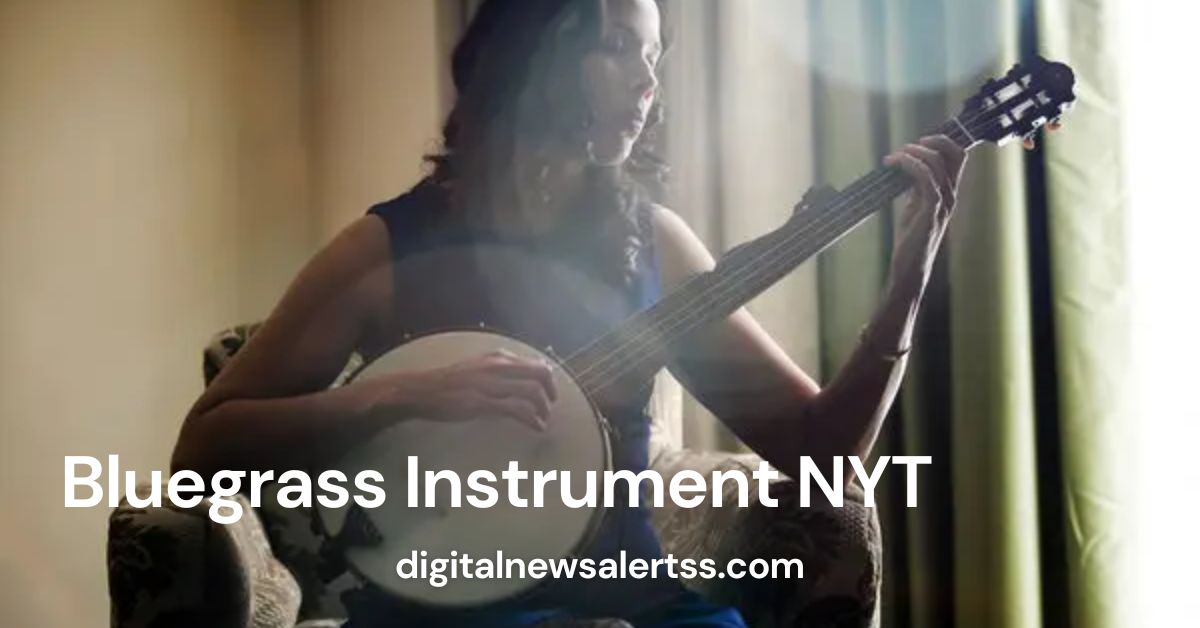Bluegrass music, with its lively melodies and rich harmonies, has captivated audiences for generations. At the heart of this uniquely American genre lies a set of instruments that give bluegrass its distinctive sound. Among these, the banjo stands out as a true icon, often appearing as a clue in crossword puzzles like the New York Times (NYT). Let’s explore the world of Bluegrass Instrument NYT, with special attention to the beloved banjo.
The Banjo: Star of the Bluegrass Show
When you think of bluegrass music, the twangy, bright sound of the banjo likely comes to mind first. This instrument, with its circular body and long neck, is a staple in any bluegrass ensemble. The banjo’s prominence is so significant that it often appears as an answer in crossword puzzles, including the prestigious New York Times crossword.
Banjo Basics
- Structure: Usually features 5 strings, though 6-string versions exist
- Playing style: Often played with a rapid-fire fingerpicking technique called “Scruggs style”
- Sound: Bright, percussive, and cutting – perfect for leading melodies and providing rhythmic drive
The banjo’s history is as rich as its sound. Originally brought to America by enslaved Africans, it evolved from gourd-based instruments into the metal-rimmed version we know today. Its adoption into bluegrass music in the mid-20th century cemented its place in American musical culture.
Other Essential Bluegrass Instrument NYT
While the banjo may steal the spotlight, it’s far from the only star in the bluegrass constellation. Let’s look at the other key players that make up a traditional bluegrass band:
- Guitar
- Role: Provides rhythm and occasional lead parts
- Playing style: Flatpicking for lead, strumming for rhythm
- Notable players: Doc Watson, Tony Rice
- Fiddle
- Role: Carries melodies and provides harmonies
- Playing style: Bowed, often with a lot of double stops (playing two strings at once)
- Notable players: Alison Krauss, Stuart Duncan
- Mandolin
- Role: Chop chords for rhythm, intricate leads
- Playing style: Tremolo picking, double stops
- Notable players: Bill Monroe (also known as the “Father of Bluegrass”), Chris Thile
- Upright Bass (Double Bass)
- Role: Provides the low-end foundation and rhythmic pulse
- Playing style: Usually plucked, sometimes slapped for percussive effect
- Notable players: Edgar Meyer, Mark Schatz
- Dobro (Resonator Guitar)
- Role: Slide guitar sounds, often used for fills and solos
- Playing style: Played horizontally with a metal slide
- Notable players: Jerry Douglas, Rob Ickes
Each of these instruments brings its own unique flavor to the bluegrass sound, creating a rich tapestry of tones and textures that define the genre.
The Banjo in Popular Culture
The banjo’s popularity extends far beyond the realm of bluegrass music. Its distinctive sound has made it a favorite in various contexts:
- Movies and TV: Often used to evoke rural or Southern settings
- Comedy: Sometimes played for comedic effect due to its bright, percussive sound
- Folk revival: Gained renewed interest during the folk music boom of the 1960s
- Crossover genres: Found in rock, jazz, and even classical music
This widespread recognition is likely why the banjo frequently appears as a clue or answer in crossword puzzles, including the New York Times crossword. Puzzle enthusiasts often find themselves searching for a five-letter word meaning “bluegrass instrument,” with “BANJO” being the satisfying answer.
Learning to Play Bluegrass Instrument NYT
If you’re inspired to try your hand at bluegrass music, here are some tips for getting started:
- Choose your instrument: While the banjo is iconic, start with whatever speaks to you most
- Listen widely: Immerse yourself in bluegrass recordings, both classic and contemporary
- Find a teacher: In-person or online lessons can help you master proper technique
- Join a jam: Bluegrass is social music – find local jam sessions to practice with others
- Be patient: Like any skill, playing Bluegrass Instrument NYT takes time and practice to master
The Future of Bluegrass Instrument NYT
While rooted in tradition, bluegrass music and its instruments continue to evolve:
- Technological advancements: Electric-acoustic hybrids and effects pedals are becoming more common
- Genre-blending: Bluegrass Instrument NYT are finding their way into diverse musical styles
- Education: Online resources make learning Bluegrass Instrument NYT more accessible than ever
Despite these changes, the core Bluegrass Instrument NYT – including the ever-popular banjo – remain at the heart of the genre’s sound and culture.
Bluegrass Festivals: Celebrating the Music and Its Instruments
To truly appreciate Bluegrass Instrument NYT in action, there’s nothing quite like attending a bluegrass festival. These events, held across the United States, showcase the best in bluegrass talent and often feature workshops where you can learn more about the instruments. Some notable festivals include:
- Grey Fox Bluegrass Festival (New York)
- Telluride Bluegrass Festival (Colorado)
- Kentucky Bluegrass Music Kickoff (Kentucky)
- Delfest (Maryland)
These festivals not only provide entertainment but also serve as a gathering place for bluegrass enthusiasts to share their love of the music and its distinctive instruments.
The Bluegrass Community: More Than Just Music
The world of bluegrass extends far beyond the instruments themselves. It’s a tight-knit community of musicians, fans, and tradition-keepers who share a passion for this uniquely American art form. This community aspect is reflected in:
- Jam sessions: Informal gatherings where musicians of all skill levels play together
- Bluegrass associations: Organizations dedicated to preserving and promoting the genre
- Instrument craftsmanship: Skilled luthiers who handcraft high-quality Bluegrass Instrument NYT
- Music camps: Intensive learning experiences for aspiring bluegrass musicians
This sense of community helps keep bluegrass music vibrant and ensures that the traditional instruments, including the beloved banjo, continue to be played and appreciated.
Bluegrass in the Digital Age
Even as bluegrass maintains its traditional roots, it’s adapting to the digital age in several ways:
- Online learning platforms: Websites and apps offering instrument lessons and technique tutorials
- Streaming services: Making vast libraries of bluegrass music accessible to listeners worldwide
- Social media: Allowing fans and musicians to connect and share their love of Bluegrass Instrument NYT
- Virtual concerts: Bringing live bluegrass performances to audiences unable to attend in person
These digital tools are introducing new generations to the joys of Bluegrass Instrument NYT and helping to ensure the genre’s continued relevance.
Conclusion: The Enduring Appeal of Bluegrass Instrument NYT
From the twang of the banjo to the sweet harmonies of fiddle and mandolin, Bluegrass Instrument NYT create a sound that’s unmistakable and deeply appealing. Whether you’re a dedicated musician, a casual listener, or just someone who enjoys solving crossword puzzles, the world of Bluegrass Instrument NYT offers something for everyone.
As we’ve explored, these instruments are more than just tools for making music – they’re carriers of tradition, symbols of a unique American art form, and gateways to a vibrant community. The next time you hear a banjo plucking out a lively tune or see it mentioned as a clue in the New York Times crossword, remember the rich history and culture behind this beloved bluegrass instrument.
So why not dive deeper into the world of bluegrass? Pick up an instrument, attend a festival, or simply listen to some classic recordings. You might just find yourself caught up in the toe-tapping, heart-stirring magic of bluegrass music and its remarkable instruments.
FAQs About Bluegrass Instrument NYT
What is the most important instrument in bluegrass music?
While all instruments play crucial roles, the banjo is often considered the most iconic bluegrass instrument. Its distinctive sound is central to the genre’s identity.
How many strings does a standard bluegrass banjo have?
A standard bluegrass banjo typically has 5 strings, though 6-string versions also exist.
Is it hard to learn Bluegrass Instrument NYT?
Like any musical skill, learning Bluegrass Instrument NYT takes time and practice. However, with dedication and proper instruction, many people find them accessible and enjoyable to learn.
What’s the difference between a fiddle and a violin?
Physically, they’re the same instrument. The term “fiddle” is commonly used in folk and bluegrass contexts, while “violin” is more often used in classical music.
Why is the banjo so popular in crossword puzzles?
The banjo’s short name and its strong association with bluegrass make it a popular choice for crossword puzzle creators, especially in clues related to music or Americana.
Can I play bluegrass on an electric guitar?
While traditional bluegrass uses acoustic instruments, many modern players incorporate electric guitars into bluegrass-inspired music.
What’s the best way to start learning a bluegrass instrument?
Start by listening to lots of bluegrass music, choose an instrument that appeals to you, and consider taking lessons from a experienced teacher or using online resources.
Are Bluegrass Instrument NYT expensive?
Prices can vary widely. While high-end professional instruments can be costly, there are many affordable options for beginners.
What’s the role of the mandolin in bluegrass?
The mandolin often provides rhythmic chop chords and intricate lead parts in bluegrass music. It’s known for its bright, crisp sound.
How often should I change the strings on my bluegrass instrument?
This depends on how often you play, but as a general rule, changing strings every 3-6 months helps maintain optimal sound quality.



